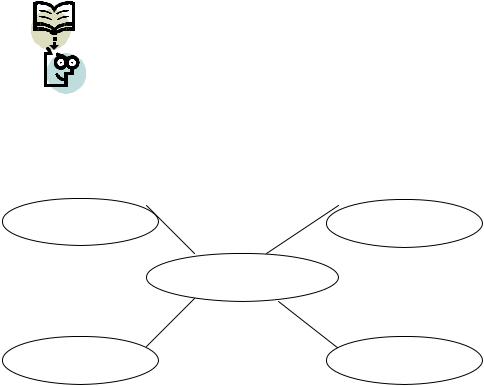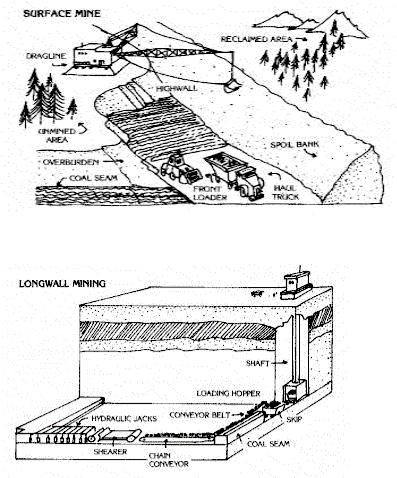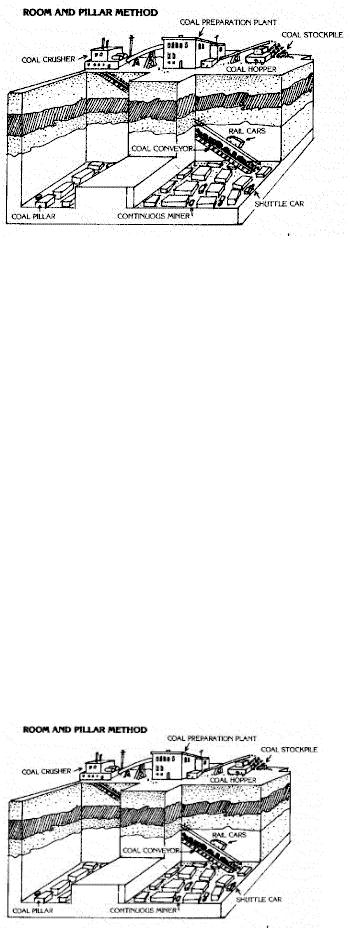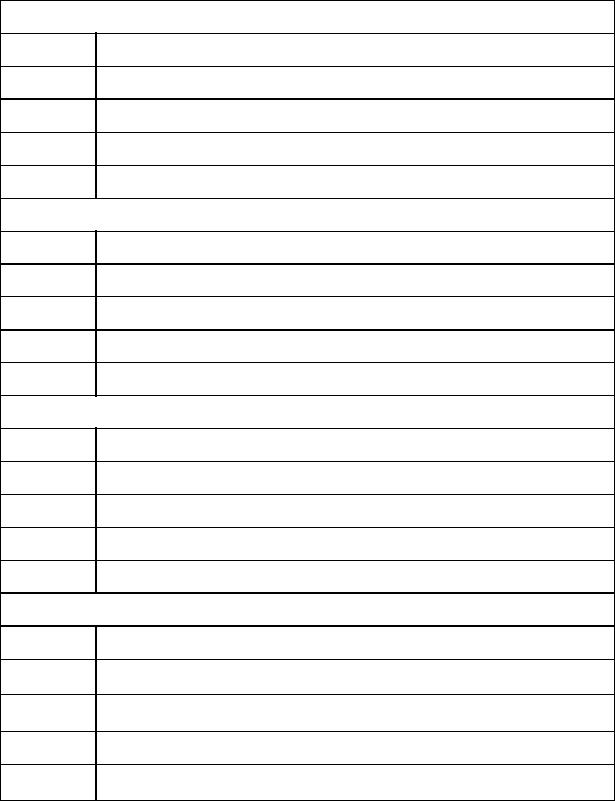
ENGLISH for Study and Work том 1
.pdf•Write a very brief ‘record card’ length summary of your own to remind you what the article is about. You may use this card when speaking about the article.
•Choose a quotation(s) from the text to use it as support in discussion.
For writing ‘record card’ see Section 2.5.1 in Part II Self-study Resources.
120198

Unit 5 Coal Extraction
Focus on
•developing a range of vocabulary relevant to coal mining
•describing charts and diagrams
•labelling diagrams
•reading and describing figures
•reading for detail
By the end of the unit you will:
•be able to read and interpret figures, charts, diagrams etc.
•be able to locate information using various clues
•be able to understand details in authentic texts related to mining
•have practised exchanging information obtained from various sources
•have practised reading and describing figures, charts, diagrams etc., instructions
•develop a range of vocabulary relevant to coal mining
Lead-in
1.Draw your mind-map (a spider gram) for coal mining. Think of methods, equipment etc. used while mining.
Coal Mining
121190

2.Pair-work. Describe your mind-map to a partner.
3.Listen to your partner’s mind-map description. Make any changes in your mind-map if appropriate.
Reading and Speaking
4.You are going to read the text. Look at the figures from the text given below and try to predict:
•What will the text be about?
•What is the title of the text?
•What will sub-headings of the text be?
5.Pair-work. Share your predictions with your partner.
6.Sign the figures. Example: Fig. 1. Surface Mining.
Fig. 1.____________________________________
Fig. 2.____________________________________________
1220

Fig. 3._______________________________________________
7. Read the text downloaded from Internet site ‘Kentucky Coal Education’ (http://www.coaleducation.org). Pay attention to the figures which illustrate the paragraphs of the text. Check the order of figures (Fig. 1 – Fig. 3) given in the previous task with those given in the text. Put them in the correct order and make any changes in signatures when necessary.
Background Information – How is coal mined?
As was the case 50 years ago, most coal is produced from two major types of mines – underground and surface. But the methods for recovering coal from the earth have undergone drastic changes in the past 25 years, as a consequence of technological advances.
Fifty years ago when most coal mining was done manually, underground mines accounted for 96 percent of the coal produced each year. Today, almost 60 percent is produced from surface mines. Most underground mines in the United States are located east of the Mississippi River, although there are some in the West, particularly in Utah and Colorado.
More than two-thirds of the coal produced underground is extracted by continuous mining machines in the room-and-pillar method. The continuous mining machine contains tungsten bits on a revolving cylinder. The continuous miner breaks the coal from the face and then conveys it to a waiting shuttle car which transports it to the conveyor belt to be moved to the surface. No blasting is needed. After advancing a specified distance, the continuous miner is backed out and roof bolts are put in place. The process is repeated until the coal seam is mined.
1232

Another method, called longwall mining, accounts for about 20 percent of production. This method involves pulling a cutting machine across a 400 to 600 foot long face (longwall) of the coal seam. This machine has a revolving cylinder with tungsten bits that shear off the coal. The coal falls into a conveyor system which carries it out of the mine. The roof is supported by large steel supports, attached to the longwall machine. As the machine moves forward, the roof supports are advanced.
The roof behind the supports is allowed to fall. Nearly 80 percent of the coal can be removed using this method. The remaining 11 percent of underground production is produced by conventional mining which uses explosives to break up the coal for removal.
Half of the minable surface coal in the United States is located in the West, but significant amounts are also present in
Appalachia and Midwestern states. Surface mining is used when the coal seam is located relatively close to the surface, making underground mining impractical.
Before a company can surface mine, it must gather information about the site regarding growing conditions, climate, soil composition, vegetation, wildlife, etc. With this information, the company then applies to the state or federal government for a permit to mine. The company must post a bond for each acre of land it mines to assure that it will be properly reclaimed.
Most surface mines follow the same basic steps to produce coal. First, bulldozers clear and level the mining area. The topsoil is removed and stored for later use in the reclamation process. Many small holes are drilled through the overburden (dirt and rock above the coal seam) to the coal seam. Each is loaded with explosives which are discharged, shattering the rock and overburden. Giant power shovels or draglines clear away the overburden until the coal is exposed. Smaller shovels then scoop up the coal and load it onto trucks, which carry the coal to the preparation plant.
Once the coal is removed, the land is returned to the desired contour and the topsoil is replaced. Native vegetation and/or trees are planted. Coal companies operating surface
1243

mines must comply with strict requirements and regulations of the Federal Surface Mining Control and Reclamation Act. A crucial part of the surface mining process is restoring a mined site to acceptable ecological conditions, which means it must be made as productive as it was prior to mining. There are farms, parks, wilderness and recreation areas on what was once surface mines.
The major stigma associated with the coal industry today is the abandoned or "orphan" mines of the early coal mining years. These orphan mines are systematically being reclaimed under the Surface Mining Act taxes coal producers at the rate of 35 cents a ton for surface mined coal, 10 cents a ton for lignite mined coal, and 15 cents a ton for underground mined coal. The tax is paid to the government and is used to reclaim the orphaned mines.
Provided by National Energy Foundation.
http://www.coaleducation.org
8. Match the terms (1 - 8) with their definitions (a - h).
1. |
room and pillar mining |
a) |
A coal mine cave-in especially in |
|
|
|
permanent areas such as entries. |
2. |
roof bolt |
b) |
An underground mine in which the |
|
|
|
main entry or access is by means of a |
|
|
|
vertical shaft. |
3. |
roof fall |
c) |
A mine in which the coal lies near the |
|
|
|
surface and can be extracted by |
|
|
|
removing the covering layers of rock |
|
|
|
and soil. |
4. |
roof support |
d) |
A method of underground mining in |
|
|
|
which approximately half of the coal is |
|
|
|
left in place to support the roof of the |
|
|
|
active mining area. Large ‘pillars’ are |
|
|
|
left until ‘rooms’ of coal are extracted. |
5. |
shaft mine |
e) |
Layers of soil and rock covering a coal |
|
|
|
seam. Overburden is removed prior to |
|
|
|
surface mining and replaced after the |
|
|
|
coal is taken from the seam. |
6. |
shortwall |
f) |
Posts, jacks, roof bolts and beams |
|
|
|
used to support the rock overlying a |
|
|
|
coal seam in an underground mine. |
|
|
|
A good roof support plan is part of mine |
|
|
|
safety and coal extraction. |
7. |
surface mine |
g) |
A long steel bolt driven into the roof of |
12543
|
|
underground excavations to support |
|
|
the roof, preventing and limiting the |
|
|
extent of roof falls. The unit consists of |
|
|
the bolt (up to 4 feet long), steel plate, |
|
|
expansion shell, and pal nut. The use |
|
|
of roof bolts eliminates the need for |
|
|
timbering by fastening together, or |
|
|
"laminating," several weaker layers of |
|
|
roof strata to build a "beam." |
8. overburden |
h) |
An underground mining method in |
|
|
which small areas are worked (15 to |
|
|
150 feet) by a continuous miner in |
|
|
conjunction with the use of hydraulic |
|
|
roof supports. |
9. Pair-work. Describe any of the figures above to your partner. While listening to your partner, sketch the mining method being described. Compare the sketch with the original drawing given in the text.
Follow-up
10.Sketch a mining method typical for your region.
11.Write the description of the figure. Be ready to give mini-presentation on mining methods used in your region. Use Part II Self-study Resources when necessary.
12654
Unit 6 Resource Extraction
Focus on
•giving mini-presentations on topics within academic and/or professional field
•reading and understanding rubrics for testing
•following test instructions
•orienting yourself to the text
•finding key ideas
•identifying main and supporting ideas of each paragraph
•skimming the text
•scanning the text
•reading for detail
•reading figures and charts
By the end of the unit you will:
•be able to read and understand rubrics for testing
•be able to understand and follow test instructions
•be able to read for detail
•be able to make mini-presentations on mining methods using the information obtained from specialism-related texts
•be able to read and understand figures illustrating texts
•be aware of various mining methods and share the information got on them from various sources
Lead-in
1. Pair-work. Being in pairs, share the mining methods you are aware of. Describe the mining method used in your region as an example.
12765

2.Group-work. Give mini-presentations of the mining methods used in your regions. Decide on what mining methods are typical for Ukraine.
3.Check your progress according to the Quiz proposed by the Internet site getinfo@osmre.gov. Before doing this Quiz read carefully the instructions given below. Instead of ‘clicking red button next to each answer’, put tick (on the left) against right answer. When you finish compare the results with your groupmates.
If possible use this site to check yourself. Compare the score with your groupmates.
Coal mining
Test Instructions:
1.Read the short paragraph below (green text)
2.Click the red button next to each answer you think is most correct.
3.If you do not know the answer, do not guess, since wrong answers are penalized.
4.If you check the wrong red button, simply click the correct one to change it.
5.If you have checked a red button with a guess and wish to deselect all red buttons for that question, just click the lit red button.
6.When finished, click the "Click When Finished Button" at the end of the test. Your score will appear below it, and all correct answers will be lit with a green button. Check the "green lit" answers you didn't know to correct your mistakes.
12876

Last year 57% of the coal was produced from surface mines and 44% from underground mines. Current mining methods require large equipment and specialized technical skills. In the last 20 years mines have become larger; but, fewer in number.
Todays mine workers need what skills?
Mining engineering
Heavy equipment operation
Blasting
Environmental problem solving
All of the above
Most mines are operated by?
Small businessmen
Colleges and universities
Land owners who have the coal resources
Large mining companies
None of the above
The mining type that produces the most coal?
Underground mining
Auger mining
Surface mining
Contour mining
None of the above
Coal can be surfaced mined if it's?
Less than 600 feet deep
Not more than 2,000 feet deep
20 to 40 feet deep
On the surface of the ground
None of the above
12987
